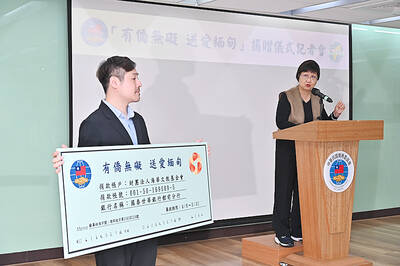The UK has changed the name of its representative office in Taiwan from the British Trade and Cultural Office to the British Office to better reflect its services.
“This is purely a change of title. It is not a change of functions,” UK Representative to Taiwan Chris Wood said yesterday.
The name change took effect on Tuesday, he said, describing it as “a rebranding.”
“We felt that the old name, the British Trade and Cultural Office, did not adequately describe what we do,” Wood said.
He said that people did not really understand what the name meant and often did not recognize the agency as a government office.
“The British Office better reflects the full scope of our work,” which ranges from providing services to British citizens in Taiwan to facilitating cooperation in science and innovation, combating climate change, supporting UK trade with Taiwan and encouraging Taiwanese investment in the UK, Wood said.
The renaming can be seen as a positive development in Taiwan-UK, relations, the Ministry of Foreign Affairs said.
The two nations are to continue to cooperate in various fields based on a solid foundation, the ministry said in a statement yesterday.
Wood said that the outcome of UK general elections earlier this month is not likely to result “in any change in the UK’s long-standing policy toward Taiwan.”
“We now have a majority Conservative government with many ministers reappointed to their previous positions,” he said.
The UK government’s key priorities remain as before — stimulating the British economy and boosting UK trade and exports, Wood said.
Taiwan and the UK have been forging stronger economic links and deepening cooperation on climate change and technology, he said.
He added that there has been an increase in the frequency of visits by senior British officials and members of parliament to Taiwan.

DEFENSE: The National Security Bureau promised to expand communication and intelligence cooperation with global partners and enhance its strategic analytical skills China has not only increased military exercises and “gray zone” tactics against Taiwan this year, but also continues to recruit military personnel for espionage, the National Security Bureau (NSB) said yesterday in a report to the Legislative Yuan. The bureau submitted the report ahead of NSB Director-General Tsai Ming-yen’s (蔡明彥) appearance before the Foreign and National Defense Committee today. Last year, the Chinese People’s Liberation Army (PLA) conducted “Joint Sword-2024A and B” military exercises targeting Taiwan and carried out 40 combat readiness patrols, the bureau said. In addition, Chinese military aircraft entered Taiwan’s airspace 3,070 times last year, up about

The Overseas Community Affairs Council (OCAC) yesterday announced a fundraising campaign to support survivors of the magnitude 7.7 earthquake that struck Myanmar on March 28, with two prayer events scheduled in Taipei and Taichung later this week. “While initial rescue operations have concluded [in Myanmar], many survivors are now facing increasingly difficult living conditions,” OCAC Minister Hsu Chia-ching (徐佳青) told a news conference in Taipei. The fundraising campaign, which runs through May 31, is focused on supporting the reconstruction of damaged overseas compatriot schools, assisting students from Myanmar in Taiwan, and providing essential items, such as drinking water, food and medical supplies,

STRICTER ENFORCEMENT: Taipei authorities warned against drunk cycling after a sharp rise in riding under the influence, urging greater public awareness of its illegality Taipei authorities have issued a public warning urging people not to ride bicycles after consuming alcohol, following a sharp rise in riding under the influence (DUI) cases involving bicycles. Five hundred and seven people were charged with DUI last year while riding YouBikes, personal bicycles, or other self-propelled two-wheelers — a fourfold increase from the previous year, data released by the Taipei Police Department’s Traffic Division showed. Of these, 33 cases were considered severe enough to be prosecuted under “offenses against public safety,” the data showed. Under the Road Traffic Management and Penalty Act (道路交通管理處罰條例), bicycles — including YouBikes and other

A magnitude 4.3 earthquake struck eastern Taiwan's Hualien County at 8:31am today, according to the Central Weather Administration (CWA). The epicenter of the temblor was located in Hualien County, about 70.3 kilometers south southwest of Hualien County Hall, at a depth of 23.2km, according to the administration. There were no immediate reports of damage resulting from the quake. The earthquake's intensity, which gauges the actual effect of a temblor, was highest in Taitung County, where it measured 3 on Taiwan's 7-tier intensity scale. The quake also measured an intensity of 2 in Hualien and Nantou counties, the CWA said.